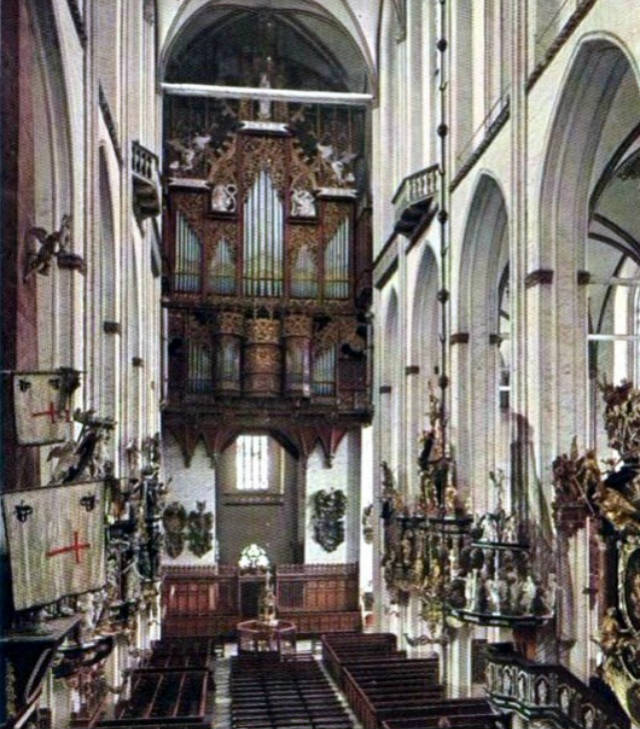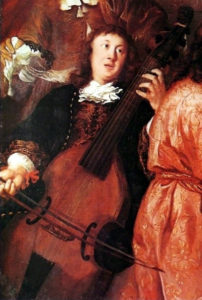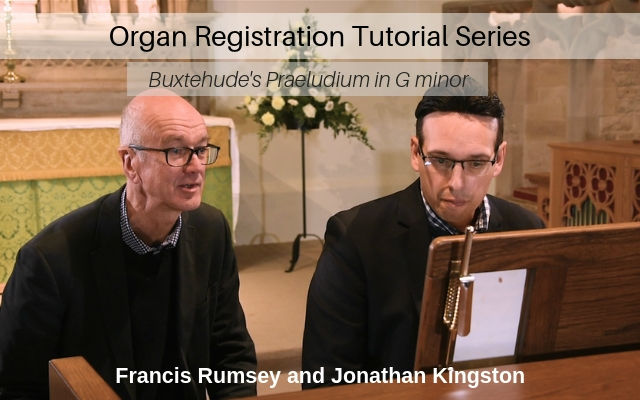For our second tutorial in the Organ Registration Tutorial Series Jonathan and Francis take a look at Buxtehude’s big G minor Praeludium, as a way in to discussing how to register baroque music of the North German school.
This piece is a great example of the so-called stylus phantasticus, and a precursor to Bach’s preludes or toccatas and fugues. The organist has a lot of freedom to register contrasting episodes, and there’s definitely more than one way to do it.
In this tutorial series Francis Rumsey and Jonathan Kingston discuss and demonstrate approaches to registration for distinctive genres and styles of organ music. In the previous tutorial Francis and Jonathan looked at registering Bach’s chorale preludes, using two contrasting trio examples.
Read more about this series in our Organ Registration Tutorial introduction and find more useful videos on the topic of organ registration.
Organ Registrations Praeludium in G minor, BuxWV 149
Buxtehude’s instrument at the Marienkirche in Lubeck was certainly a big beast. The main organ had a substantial specification of 52 stops that almost certainly included a 32 foot principal rank and some big pedal reeds. This implies a certain licence for organists not to hold back on their registrations with Buxtehude’s big organ works, when it seems appropriate. This piece cries out for interesting contrasts between sections, nonetheless.

The first section of Praeludium in G minor is a dramatic Toccata-like movement. Jonathan shows us how he would register a plenum (typically a principal chorus up to mixtures) at the opening. Then demonstrates the effect of adding some reeds on top of the plenum, and brings out the mighty pedal line with some big pedal reeds.
Moving on to the section that follows, we find a short fugal episode, which Jonathan registers in much more delicate fashion compared with the opening. This leads into a short cadential linking section at the end of the fugue, which seems to imply a gradually decreasing dynamic and some opportunities for improvisation or embellishment.
Options for a fairly bold registration?

Then we move on to a lively third movement. Some editions have the organist hopping about on the pedals for the quaver accompaniment, but some put it in the left hand, so Jonathan demonstrates the options. He suggests that the choice is very much down to the organist and how brave they are feeling.
Finally there’s the long finale in three time, which suggests double dotting and a fairly bold registration. Francis asks Jonathan what he thinks about a gradual build of the registration on the last page as the piece reaches its final peroration. Is it corny, or could it work?
We hear examples that suggest the player might not need to be too coy about a dramatic conclusion. Especially if the organ has a suitable specification and the voicing of the reeds is appropriate for the style of music.
Follow the Organ Registration Series on YouTube
Note! Videos to be released during the year. To keep up to date with the latest news/blogs we suggest subscribing to our newsletter and following us on Facebook or Twitter.

I’m a retired academic, with a background in music and audio engineering. I’m currently a consultant for Viscount & Regent Classic Organs, as well as being a freelance organist, including a role as organist/choirmaster at St Mary’s, Witney. I sing bass with Oxford Pro Musica Singers and the Cathedral Singers of Christ Church, Oxford.




Hello! I am currently learning Buxtehudes Prelude & Fugue in e minor Bux 142. I have been listenng to examples on You Tube and note the wide variation in the timpo’s used. Tom Koopman seems to be ‘out in front’ as regards tempo whilst others appear to adopt the maxim that a slower tempo, well articulated has merits. Is it your opinion that in Buxtehude’s time, tempos were generally slower than many current performers would want us to believe?
Colin, The answer to the question is well beyond my pay grade so I referred it back to Jonathan. Here is what he has to say.
I am by no means a North German Baroque expert however I would bring to the table:
1. Formal tempo indications were rarely placed onto scores, particularly those scripted in tablature by Bux, Bruhns, Böhm etc in that generation slightly before JSB
2. Tempi could be gauged from similar dance styles in the period which is why Chaconnes, Passacaglias etc assume the pace they do, however that word is key ‘assume’ as there could be quite a difference from performer to performer, rather akin to the English language prior to standardised spelling. A phonetic equivalent was equally acceptable to the ‘correct’ way.
3. Organ action, building acoustic and whether the piece was intended to church or secular used also a key factor, and the one I am most led by. Go for rhythmic flow, fine clarity and a sense of line which are within the capabilities of the performer, instrument and surrounding acoustic and really, one won’t go too far wrong.
I hope that helps. Regards David